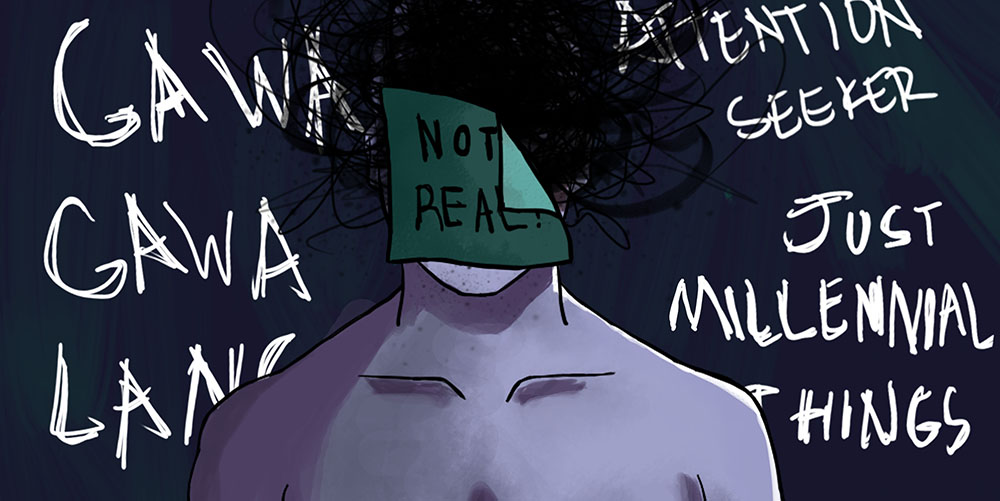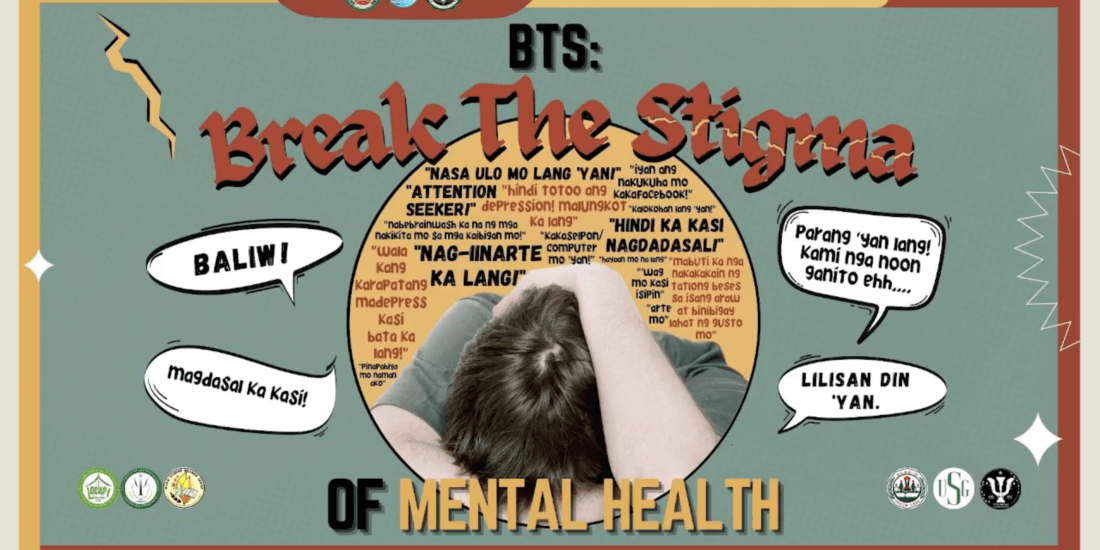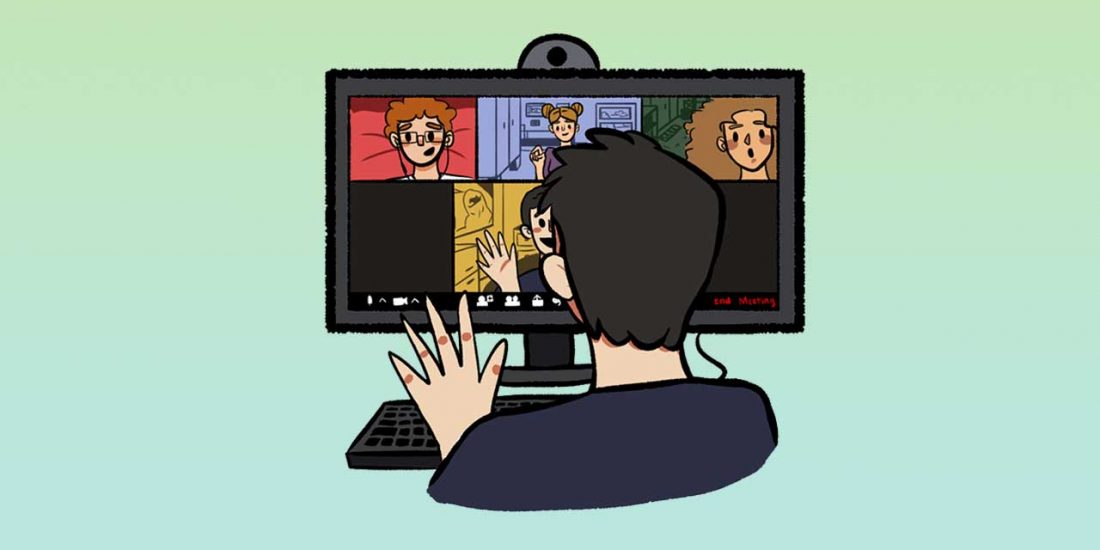Mental health: Not “gawa-gawa lang”

Choose your journey: You’re in a discussion about depression and you have to express your opinion about it. Will you (a) respond passively, (b) discuss its reality, or (c) say that it’s “gawa-gawa lang”?
There’s no arguing that one can easily say that (b) is the right choice. However, we can argue that not everyone will think the same way—worse, some will choose not to give a damn at all. Yet passivity isn’t the worst case scenario as there are some who will choose the thoughtless “gawa-gawa lang” option (yes, we’re pointing at you, Joey De Leon). Mental illnesses, like depression, aren’t something we can shrug off and see as something one can overcome by positive thinking—because, in reality, it’s not all in the mind.
The clash of ignorance and ignominy
Mental health, according to the World Health Organization, is a state of wellbeing where we realize our own potential which “can cope with the normal stresses of life, can work productively and fruitfully, and is able to make a contribution to their community.” So, the wellbeing of mental health is every individual’s human right, whether young or old, rich or poor. But what happens when ignorance in mental health and prejudice to its patients collide? Simple—stigmas spark.
Prejudices against people with mental illnesses have become prevalent, reveals a research published in the British Journal of Psychiatry entitled Stigmatisation of people with mental illnesses. The most negative opinion claims that people with mental illnesses are “dangerous”—the wrong sort of thinking that leads people to deep isolation and distress. More than that, the Institute of Mental Health (IMH) in Singapore found through a study that nine out of 10 believe that mental health patients could get better if they just wanted to—as if mental health is controllable. Comprised of 3,000 respondents, the researchers said that mental health patients may avoid seeing a doctor because of the shame and deterrence brought by the stigma.
The truth is, stigma acts like a tiny spark in a dry forest—igniting a wildfire that ashes a mental health patient’s self-esteem and self-efficacy. And this type of stereotyping has become common in the Philippine context, as depression and other mental illnesses are falsely viewed as a matter of “gawa-gawa lang”.
Debunking ‘all in the mind’
For some, it’s easy to stigmatize those who suffer mentally. Comments like “huwag mong lapitan ‘yan, baliw ‘yan” or “it’s their choice naman kung magiging better sila o hindi” are pervasive. That’s the thing—people assume that mental health is all mind over matter as if it’s a choice to make, however what few understand is that many mental illnesses aren’t all in the mind as physiological factors like hormones and genetics refute this slurring mentality.
A key example is the fact that depressed people experience “hyperactivity” in a portion of the brain called Brodmann Area 25. This makes a person experience various physical and psychological symptoms, including the overwhelming feeling of sadness and the loss of interest on anything, including tasks a person usually enjoys. Symptoms likewise constitute an abrupt change in appetite, sleep irregularity, energy loss, and increased fatigue—episodes that aren’t clearly just made-up for self-pity drama, as others might assume.
Sadly, apart from difficulties in concentration and decision-making, the long rope of symptoms can oftentimes lead to suicidal thoughts due to the feeling of insignificance, guilt, and regret. Other suicide cases are linked to the decreased concentration of serotonin in the brain, a chemical essential for the overall feeling of well-being. Suffice to say, mental illnesses aren’t always about what and how a person thinks as biology proves that it doesn’t solely grow from one’s thoughts, and it can’t be cured by only thinking it can be.
Most people believe that mental health patients should always remain positive and that they’ll be better afterward if they do. However, the think-happy-thoughts mantra straight out of a Peter Pan film isn’t always effective. While it’s important for mental health patients to be optimistic, there’s no denying that they need more actual support from the presence of a parent or a face-to-face conversation with a friend, like what Jane Brody wrote on Social Interaction Is Critical for Mental and Physical Health. According to her, “people who are chronically lacking in social contacts are more likely to experience elevated levels of stress and inflammation.”
Consequently, we can help people overcome depression and other mental ailments by supporting them all the way through to healing, especially if it’s the best that we can do.
Not yet over
Perhaps you’ve seen the Project Semicolon, a mental health awareness campaign that started in 2013. The project used a semicolon because it “is used when an author could’ve chosen to end their sentence, but chose not to. The author is you and the sentence is your life.”
Lead by Amy Bleuel, who has a small semicolon tattoo on her wrist in honor of her father who took his own life, the movement began small just like the symbol that represents it. But, with the help of social media, it soon grew viral—and rightly so.
Fortunately, Project Semicolon has reached the Philippines—keeping the mission of suicide prevention and mental health awareness ablaze on social media through Facebook profile picture filters and Twitter hashtags. Recently, #keepgoing, a campaign started by Nadine Lustre, became trending online after her brother reportedly took his own life. Supported by chiliad social media users including famous celebrities and supportive fans, the trend became a movement for the compassion and care for suicidal people. In a nation where stigma seems like a norm, it’s a breath of fresh air that many individuals, especially millennials, are with the trend of self-awareness of mental health—producing new manifold advocates.
Aiming to intensify consciousness about the bill, the advocates’ primary priority is the Mental Health Act of 2017 (Senate Bill No. 1354). Its goal is to ensure that all Filipinos are mentally healthy through an efficient mental health care system, while promoting mental health and protecting patients. “The bill also mandates the government to put up basic mental health services at the community level,” Senator Risa Hontiveros, the principal sponsor of the bill, explained. “And psychiatric, psychosocial and neurologic services in all regional, provincial, and tertiary hospitals.” Unfortunately, though already approved by the Senate, the Mental Health Bill has been pending in the House of Representatives since May. On the other hand, the House has okayed the Comprehensive Mental Health Act (House Bill Number 6452), which covers the rights of mental health patients, including drug-dependent individuals who may turn out to be mentally ill.
According to Dr. Lourdes Ignacio of Philippine Psychiatric Association, one in every three Filipinos have mental health problems—that’s equivalent to more than 28.48 million Filipinos suffering mentally. The WHO lists depression as the top cause of ill health and disability worldwide—more than 300 million people are suffering from depression. In the Philippines alone, over 4.5 million cases of depression were reported, making it as Southeast Asian country with the highest incidence of depression. These are but a few of why mental health advocates seek for the fast legislation of the MH Act—it’s a step onwards for the best of both the mentally ill and the unaware.
Seemingly, the history of mental health and its advocates encompasses a bright silver lining for the future of mental health in the Philippines—revealing how a generation redefines a simple punctuation mark to remind people to “stay strong; love endlessly; change lives.”
***
Perhaps, after reading this article, you’ll never look at mental health and mental health patients the same way again. Hopefully, gone are the stigmatizing jokes and the “gawa-gawa lang” mentality. Besides, this is no laughing matter.
If you have chosen (b) as your journey, then congratulations—you chose the path that’s doubtlessly right. But if not, then it’s time to correct the error—after all, it’s the henyo thing to do.





